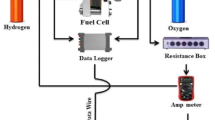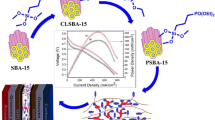Abstract
Gamma irradiation was used for cross-linking poly (vinyl alcohol) (PVA) and glycidyl methacrylate (GMA) mixtures of different compositions. Specifically, 0.5 wt% titanium dioxide (TiO2) nanoparticles were added and blended well with the casting mixture prior to exposure to the irradiation dose. Next, 10 kGy was found to be the optimum dose for achieving the desired physical and chemical properties of the membrane. Characterizations of the cast membranes were carried out by Fourier transformer infrared (FTIR) spectroscopy, thermogravimetric analysis (TGA), scanning electron microscopy (SEM), and positron annihilation lifetime spectroscopy (PALS). The properties of the membrane were also characterized by ion exchange capacity (IEC), water uptake, and tensile strength and were assessed in relation to application in proton exchange membrane fuel cells (PEMFCs). A maximum proton conductivity of 7.3 × 10−2 S cm−1 was obtained for the membrane having 20 % GMA, 80 % PVA, and 0.5 % TiO2, and its activity and durability in a membrane electrode assembly (MEA) were compared to those of a commercial Nafion® 1350.







Similar content being viewed by others
References
Wieser C (2004) Novel polymer electrolyte membranes for automotive applications requirements and benefits. Fuel Cells 4:245–250
Devanathan R (2008) Recent developments in proton exchange membranes for fuel cells. Energ Environ Sci 1:101–119
Jagur-Grodizinski J (2007) Polymeric materials for fuel cells: concise review of recent studies. Polym Adv Technol 18:785–799
Huang YF, Kannan AM, Chang CS, Lin CW (2011) Development of gas diffusion electrodes for low relative humidity proton exchange membrane fuel cells. Int J Hydrog Energy 36:2213–2220
Maria TMC, Carvalho RA, Sobral PJA, Habitante AMBQ, Solorza-Feria J (2008) The effect of the degree of hydrolysis of the PVA and the plasticizer concentration on the color, opacity, and thermal and mechanical properties of films based on PVA and gelatin blends. Food Eng J 87:191–199
Mendieta-Taboada OWM, Sobral PJA, Carvalho RA, Habitante AMBQ (2008) Thermomechanical properties of biodegradable films based on blends of gelatin and poly(vinyl alcohol). Food Hydrocoll 22:1485–1492
Silva GGD, Sobral PJA, Carvalho RA, Bergo PVA, Taboada OWM, Habitante AMQB (2008) Biodegradable films based on blends of gelatin and poly (vinyl alcohol): effect of PVA type or concentration on some physical properties of films. Polymer Environ J 16:276–285
Alves PMA, Carvalho RA, Moraes ICF, Luciano CG, Bittante AMQB, Sobral PJA (2011) Development of films based on blends of gelatin and poly(vinyl alcohol) cross linked with glutaraldehyde. Food Hydrocoll 25:1751–1757
Chauhan SG, Guleria L, Sharma R (2005) Synthesis, characterization metal ion sorption studies of graft copolymers of cellulose with glycidyl 15 16 methacrylate and some comonomers. Cellulose 12:97–110
Jeon MY, Park KY, Kim CK (2008) Performance changes of composite 20 membranes prepared from various glycidyl methacrylate derivatives and their mixtures. J Membr Sci 308:87–95
Sambandam S, Ramani V (2007) SPEEK/functionalized silica composite membranes for polymer electrolyte fuel cells. J Power Sources 170:259–267
Wu H, Cao Y, Li Z, He G, Jiang Z (2015) Novel sulfonated poly (ether ether ketone)/phosphonic acid-functionalized titania nanohybrid membrane by an in situ method for direct methanol fuel cells. J Power Sources 273:544–553
Chun-Chen Y, Yingjeng JL, Tzong-Horng L (2011) Preparation of novel poly(vinyl alcohol)/SiO2 nanocomposite membranes by a sol–gel process and their application on alkaline DMFCs. Desalination 276:366–372
Chen J, Maekawa Y, Asano M, Yoshida M (2007) Double crosslinked Poly ether ether ketone-based polymer electrolyte membranes prepared by radiation and thermal crosslinking techniques. Polymer 48:6002–6009
Vankelecom IFJ, DeSmet K, Gevers LEM, Jacobs PA (2005) in vol. eds.: Schafer AI, Fane AG, Waite TD, Nanofiltration: Principles and Applications, Elsevier, Oxford pp. 33–65
Vandezande P, Geversz LEM, Jacobs PA, Vankelecom IFJ (2009) Preparation parameters influencing the performance of SRNF membranes cast from polyimide solutions via SEPPI. Sep Purif Technol 66:104–110
El-Hadi A, Schnabel R, Straube E, Müller G, Henning S (2002) Correlation between degree of crystallinity, morphology, glass temperature, mechanical properties and biodegradation of poly (3-hydroxyalkanoate) PHAs and their blends. J Polymer Testing 21:665–674
Kim M, Saito K (2000) Radiation-induced graft polymerization and sulfonation of glycidyl methacrylate on to porous hollow-fiber membranes with different pore sizes. Radiat Phys Chem J 57:167–172
Kim DS, Park HB, Rhim JW, Lee YM (2004) Preparation and characterization of crosslinked PVA/SiO2 hybrid membranes containing sulphonic acid groups for direct fuel cell application. J Membr Sci 240:37–48
Rouilly M, Kotz ER, Hans O, Scherer GG, Chapiro A (1993) Proton exchange membrane prepared by simultaneous radiation grafting of styrene onto Teflon 46 47 FEP, films synthesis and characterization. J Membr Sci 81:89
Olsen JV, Kirkegaard P, Pedersen NJ, Eldrup M (2007) PALS fit: a new program for the evaluation of positron lifetime spectra. Physica Status Solidi C 4:4004
Walsby N, Paronen M, Juhanoja J, Sundhoulm F (2001) Sulfonation of styrene grafted poly (vinylidene fluoride) films. J Appl Polym Sci 81:1572–1580
Jie-Cheng T, Lin C-K (2011) Effect of PTFE content in gas diffusion layer based on Nafion/PTFE membrane for low humidity proton exchange membrane fuel cell. J Taiwan Inst Chem Eng 42:945–951
Ulaganathan M, Pethaiah SS, Rajendran S (2011) Li-ion conduction in PVAc based polymer blend electrolytes for lithium battery applications. Mater Chem Phys 129:471–476
Li Z, Su G, Wang X, Gao D (2005) Micro-porous P (VDF-co-HFP) –based polymer electrolyte filled with Al2O3 nanoparticles. Solid State Ionics 176:1903–1908
Abdel-Hady EE, El-Toony MM, Abdel-Hamed MO (2013) Grafting of glycidyl methacrylate/styrene onto poly vinyldine fluoride membranes for proton exchange fuel cell. Electrochim Acta 103:32–37
Lu JL, Fang QH, Li SL, Jiang SP (2013) Novel phosphotungstic acid 42 43 impregnated meso-Nafion multilayer membrane for proton exchange membrane fuel cells. J Membr Sci 427:101–107
Xi Y, Frost RL, He H, Kloprogge T, Bostrom T (2005) Modification of wyoming montmorillonite surfaces using a cationic surfactant. Langmuir 21:8675–8680
Jean YC, PE Mallon, Schrader DM (2003) Principles and applications of positron and positronium chemistry. Eds.; World Sci. Pub.: Singapore
Jean YC, Chen H, Zhang S, Chen H, Lee LJ, Awad S, Huang J, Lau CH, Wang H, Li F, Chung T-S (2011) Characterizing free volumes and layer structures in polymeric membranes using slow positron annihilation spectroscopy. J Phys Conf Ser 262:012027
Xu C, Cao Y, Kumar R, Wu X, Wang X, Scott K (2011) A poly benzimidazole /sulfonated graphite oxide composite membrane for high temperature polymer electrolyte membrane fuel cells. J Mater Chem 21:11359
Xu C, Liu X, Cheng J, Scott K (2015) A polybenzimidazole /ionic-liquid-graphite-oxide composite membrane for high temperature polymer electrolyte membrane fuel cells. J Power Sources 274:922–927
Callister WD (2007) Materials science and engineering: an introduction, 7th edn. John Wiley & Sons, New York
Kim NH, Mishra AK, Kim D, Lee JH (2015) Synthesis of sulfonated poly(ether ether ketone)/layered double hydroxide nanocomposite membranes for fuel cell applications. Chem Eng J 272:119–127
Chempath S, Einsla BR, Pratt LR, Macomber CS, Boncella JM, Rau JA, Pivovar BS (2008) Mechanism of tetra alkyl ammonium head group Degradation in Alkaline Fuel Cell Membranes. J Phys Chem C 112:3179–3182
Ong AL, Saad S, Lana R, Goodfellow RJ, Tao S (2011) Anionic membrane and ionomer based on poly(2,6-dimethyl-1,4-phenylene oxide) for alkaline membrane fuel cells. J Power Sources 196:8272–8279
Borup R, Meyers J, Pivovar B, Kim YS, Mukundan R, Garland N, Myers D, Wilson M, Garzon F, Wood D, Zelenay P, More K, Stroh K, Zawodzinski T, Boncella J, McGrath JE, Inaba M, Miyatake K, Hori M, Ota K, Ogumi Z, Miyata S, Nishikata A, Siroma Z, Uchimoto Y, Yasuda K, Kimijima KI, Iwashita N (2007) Scientific aspects of polymer electrolyte fuel cell durability and degradation. Chem Rev 107:3904–3951
Bauer B, Jones DJ, Roziere J, Tchicaya L, Alberti G, Casciola M, Massinelli L, Peraio A, Besse S, Ramunni E (2000) Electrochemical characterisation of sulfonated polyetherketone membranes. J New Mater Electrochem Syst 3:93–98
Yu J, Matsuura T, Yoshikawa Y, Islam M, Hori M (2005) Lifetime behavior of a PEM fuel cell with low humidification of feed stream. Phys Chem Chem Phys 7:373–378
Chen J, Asano M, Maekawa Y, Yoshida M (2008) Fuel cell performance of poly ether ether ketone-based polymer electrolyte membranes prepared by a two-step grafting method. J Membr Sci 319:1–4
Acknowledgments
The authors sincerely thank the STDF of Egypt (ID220) for financially supporting this project.
Author information
Authors and Affiliations
Corresponding author
Rights and permissions
About this article
Cite this article
El-Toony, M.M., Abdel-Hady, E.E. & El-Kelesh, N.A. Casting of poly (vinyl alcohol)/glycidyl methacrylate reinforced with titanium dioxide nanoparticles for proton exchange fuel cells. J Solid State Electrochem 20, 1913–1920 (2016). https://doi.org/10.1007/s10008-016-3186-7
Received:
Revised:
Accepted:
Published:
Issue Date:
DOI: https://doi.org/10.1007/s10008-016-3186-7




